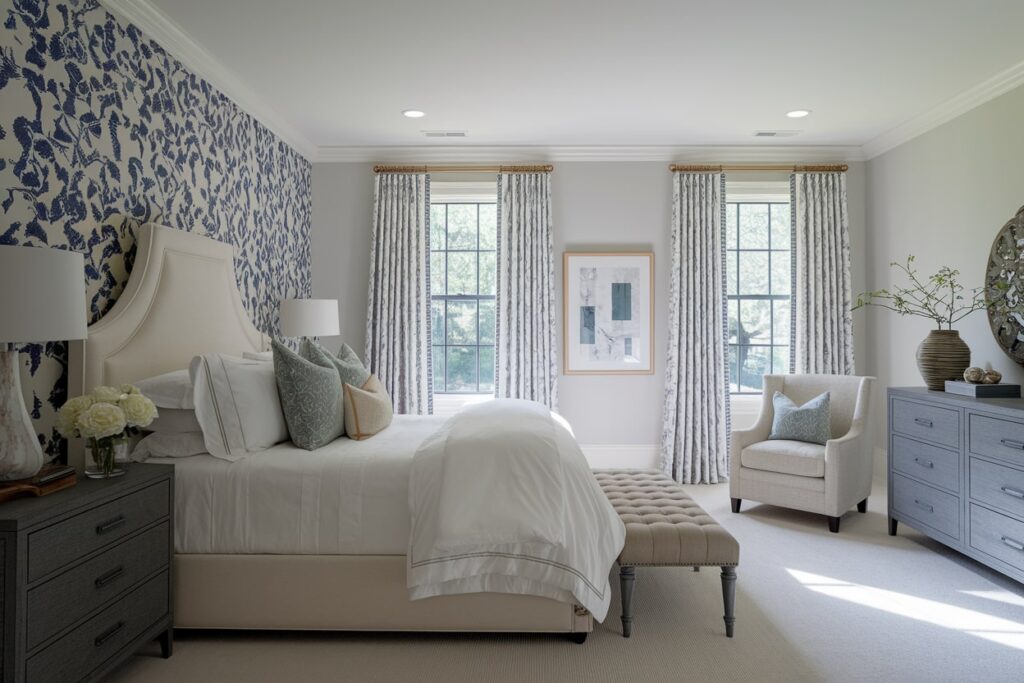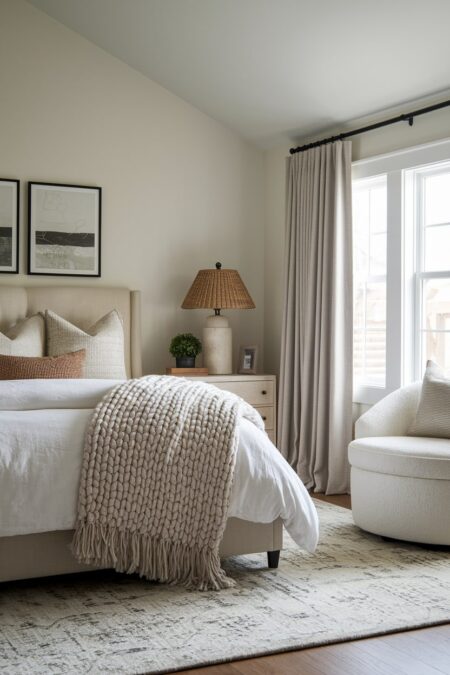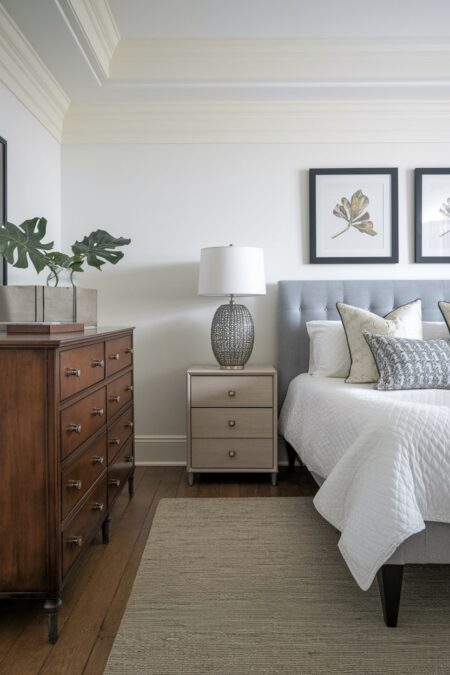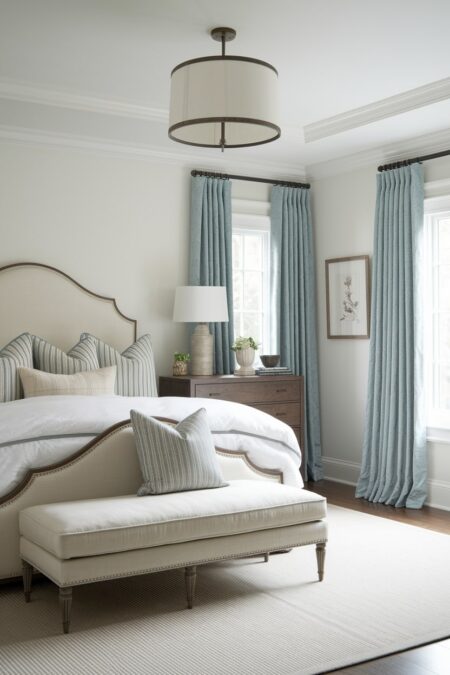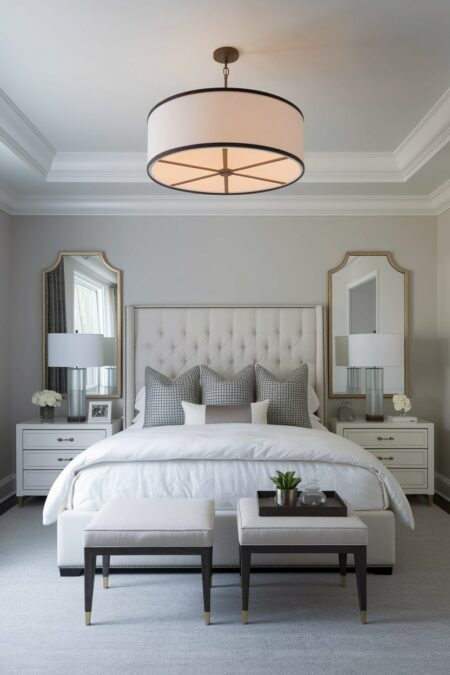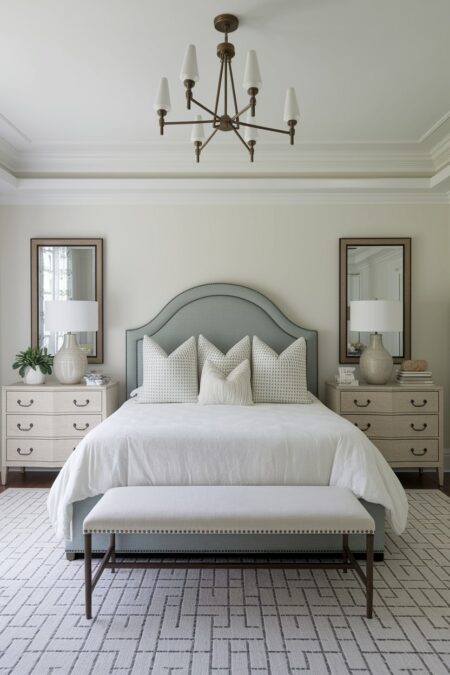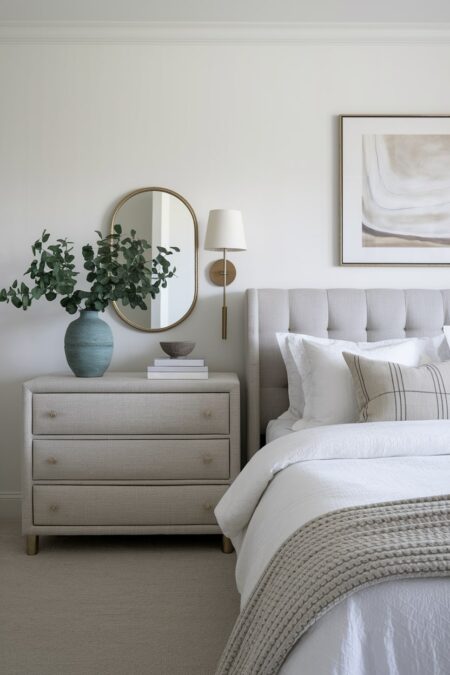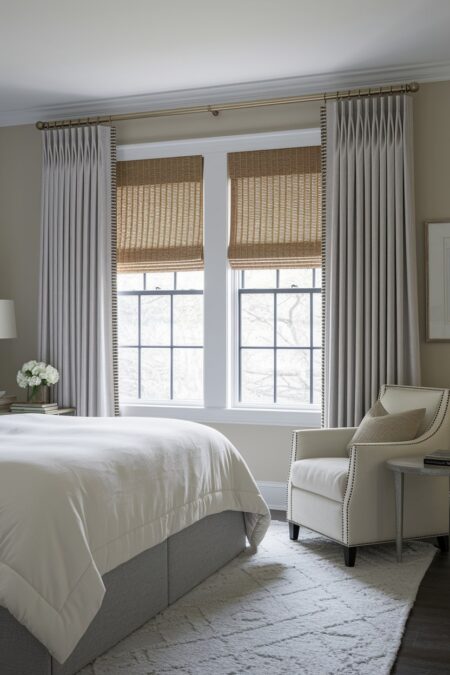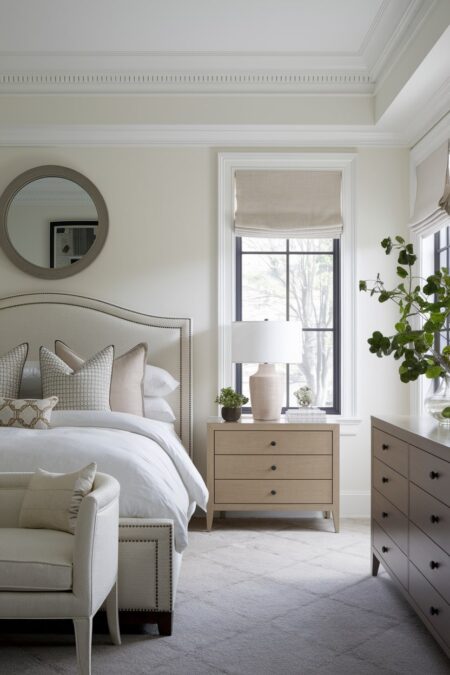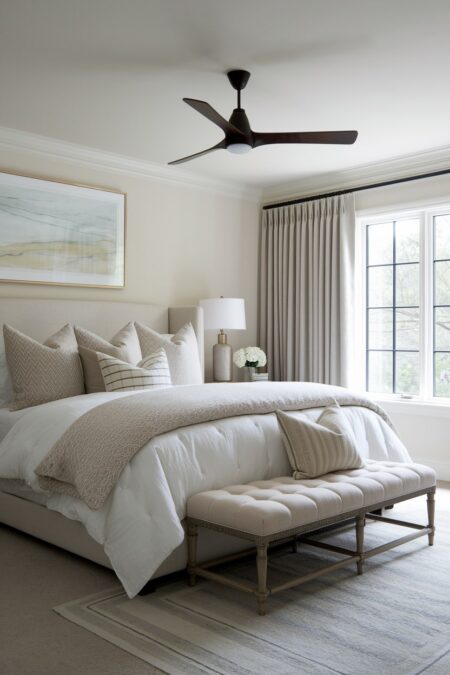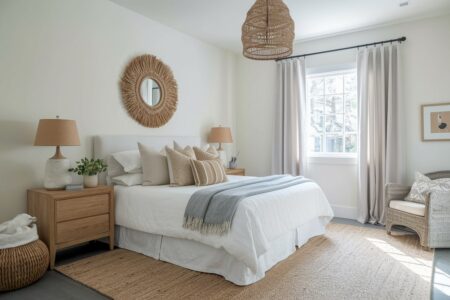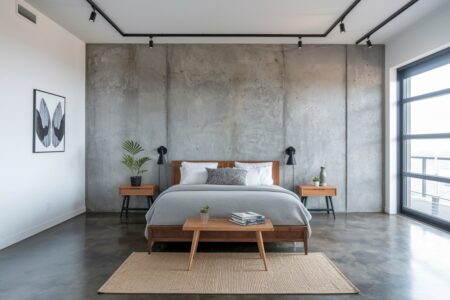The transitional style has emerged as a favorite in interior design for its ability to create spaces that are both elegant and genuinely livable. It masterfully bridges the gap between the ornate details of traditional decor and the clean, stark lines of contemporary aesthetics. The result is a balanced, serene, and timeless sanctuary. A transitional bedroom, in particular, offers a soothing retreat that feels both current and enduring. It avoids being tied to a fleeting trend, instead focusing on sophisticated comfort. If you’re looking to cultivate this harmonious blend of old and new, here are foundational ideas to guide you in creating the perfect transitional bedroom.
-
01 of 13
Build on a Neutral Color Foundation
The cornerstone of any transitional space is a calm and sophisticated color palette. Begin by selecting a foundation of neutral tones for the walls and largest furniture pieces. Shades like soft grays, warm taupes, creamy off-whites, and classic beige create a serene backdrop that allows other design elements to shine. This approach doesn’t mean the room has to be boring; rather, it establishes a cohesive and peaceful atmosphere. You can introduce depth by using varying shades of the same neutral family, creating a monochromatic scheme that is rich in subtlety and elegance.
To bring this idea to life, consider painting your walls a light, inviting color like greige or a soft tan. This will make the room feel larger and more open. When selecting your bed frame or dresser, opt for pieces in these same calming hues. This neutral base provides the perfect canvas for layering textures and introducing subtle accent colors through smaller decor items, which can be easily updated over time without requiring a complete room overhaul.
RELATED: 24 Neutral Bedroom Ideas to Create a Calming Retreat
-
02 of 13
Incorporate Rich Textural Layers
With a neutral color palette in place, the key to adding warmth and visual interest is through texture. A successful transitional bedroom invites you in with a rich variety of materials that are pleasing to both the eye and the touch. Think about how different surfaces interact and complement one another. The goal is to create a multi-sensory experience that feels cozy and luxurious without being cluttered.
Focus on layering different materials throughout the space. Combine a plush wool area rug underfoot with soft linen curtains, a chunky knit throw blanket on the bed, and perhaps a smooth velvet accent chair in the corner. Even small details, like lampshades made of natural fibers or wooden decor pieces, contribute to this textural tapestry. This deliberate layering prevents the neutral color scheme from feeling flat and adds a dimension of sophisticated comfort that is central to the transitional style.
-
03 of 13
Select a Statement Upholstered Headboard
The bed is the natural focal point of any bedroom, and in a transitional design, an upholstered headboard serves as the perfect anchor. It introduces softness, texture, and a touch of traditional elegance that beautifully balances more modern elements in the room. Whether you choose a design with classic button tufting or one with a more streamlined, clean-lined silhouette, an upholstered headboard adds a sense of comfort and luxury.
When choosing your headboard, consider a durable yet inviting fabric like linen, velvet, or a textured weave in a neutral color that complements your wall color. The shape can also influence the room’s overall feel. A headboard with gentle curves can soften the space and add a feminine touch, while a more rectangular shape reinforces a sense of modern structure. This single piece can effectively set the tone for the entire room’s design.
-
04 of 13
Mix Furniture Styles with Care
The art of transitional design lies in its skillful blending of different eras and styles. Rather than purchasing a matching bedroom set, curate a collection of individual pieces that speak to both classic and contemporary sensibilities. This curated approach gives the room a unique personality and a feeling of being assembled over time. The key is to find a common thread that ties the disparate pieces together, creating a look that is cohesive rather than chaotic.
To achieve this balance, you might pair a traditional wooden dresser with sleek, modern nightstands that feature clean lines and metallic hardware. Alternatively, a contemporary platform bed can be beautifully offset by a pair of ornate, vintage-inspired table lamps. The unifying element could be a consistent wood tone, a repeated color, or a shared material like metal, which ensures that despite their different styles, all the pieces feel like they belong in the same space.
-
05 of 13
Choose Timeless Furniture Profiles
When selecting furniture for a transitional bedroom, look for pieces with timeless silhouettes. This means avoiding anything that is overly ornate and detailed, as well as anything that is excessively stark or minimalist. The ideal furniture profile has clean, simple lines but incorporates soft curves or subtle details that prevent it from feeling cold. The scale of the furniture is also important; it should feel substantial and comfortable without overwhelming the room.
Look for dressers, nightstands, and benches that are well-proportioned and feature simple, elegant hardware. A bed frame with a gentle arch or a dresser with tapered legs are excellent examples of this principle. These pieces feel grounded and classic, ensuring that your bedroom’s design will not feel dated in a few years. They provide a solid, enduring foundation for your personal sanctuary.
-
06 of 13
Install Elegant and Modern Lighting
Lighting is a critical element in setting the mood of a transitional bedroom. A well-designed space will feature multiple layers of light that are both functional and beautiful. Start with a central overhead fixture that makes a statement. This could be a modern interpretation of a classic chandelier or a large-scale drum pendant that adds a touch of contemporary drama. This main fixture acts as a piece of jewelry for the room.
Supplement your overhead lighting with task lighting, such as a pair of sophisticated table lamps on the nightstands or sleek wall sconces mounted on either side of the bed. These lamps can introduce a different style element; for example, if your ceiling fixture is more traditional, you might opt for lamps with a more modern, sculptural base. This mix of lighting styles adds complexity and allows you to control the ambiance, whether you need bright light for reading or a soft glow for winding down.
-
07 of 13
Utilize Symmetrical Layouts for Balance
A sense of order and balance is fundamental to the serene feeling of a transitional bedroom. One of the most effective ways to achieve this is by creating a symmetrical layout centered around the bed. Placing matching nightstands on either side of the bed, each topped with a matching lamp, establishes a feeling of harmony and intention. This classic design technique is calming to the eye and makes the space feel organized and restful.
This symmetry can extend beyond the immediate bedside area. Consider placing a bench at the foot of the bed or hanging a pair of complementary art pieces on the wall opposite the bed. While the overall design embraces a mix of styles, the underlying structure provided by a symmetrical arrangement creates a sense of stability that allows the more eclectic elements to coexist peacefully.
-
08 of 13
Accessorize with Understated Decor
In a transitional bedroom, less is often more when it comes to accessories. The goal is to choose a few high-quality, meaningful pieces that enhance the room’s serene atmosphere rather than creating clutter. Avoid filling every surface with small trinkets. Instead, select items that have personal significance or contribute to the room’s overall texture and color story. A minimalist approach to decorating helps maintain the clean, uncluttered feel of the space.
Consider placing a simple, elegant vase with fresh greenery on a dresser, stacking a few curated books on a nightstand, or hanging a single, large-scale piece of abstract art above the bed. A beautifully framed mirror can also serve as both a functional item and a piece of decor, helping to reflect light and make the space feel larger. Each accessory should feel purposeful and contribute to the room’s overall sense of calm sophistication.
-
09 of 13
Ground the Space with a Quality Area Rug
An area rug is essential for anchoring the furniture in a transitional bedroom and adding another layer of texture and warmth. It helps to define the sleeping area and makes the entire room feel more cohesive and complete. Position the rug so that it extends at least two feet on either side of the bed, providing a soft surface to step onto in the morning.
When selecting a rug, opt for one made from natural fibers like wool or a soft synthetic blend that feels luxurious underfoot. The pattern should be subtle enough to complement the serene environment. Understated geometric designs, soft abstract patterns, or even a solid-colored textured rug are excellent choices. The rug’s colors should tie into the room’s neutral palette while perhaps introducing a gentle accent hue.
-
10 of 13
Layer Your Window Treatments
Elegant and functional window treatments are a hallmark of well-designed transitional interiors. Layering different types of window coverings provides a look that is both polished and practical, giving you complete control over light and privacy. This approach adds softness and dimension to the walls, framing the windows and enhancing the room’s overall sense of comfort.
Start with a functional base layer, such as woven wood shades, Roman shades, or simple blinds, which allow you to filter light during the day. Over this, hang a pair of soft, high-quality drapery panels. Choose curtains made from a luxurious material like linen, a cotton blend, or velvet in a color that coordinates with your wall or bedding colors. The hardware should also be considered; a simple metal rod in a brushed nickel or soft brass finish adds a final touch of understated elegance.
-
11 of 13
Integrate Subtle Metallic Accents
A touch of metal can elevate a transitional bedroom from simple to sophisticated. Introducing metallic accents adds a subtle layer of glamour and reflects light, brightening the space. The key is to use them sparingly and choose finishes that are soft and warm rather than overly bright and shiny. Think of these accents as the finishing touches that tie the entire design together.
Incorporate metals through hardware on your dresser and nightstands, the base of your table lamps, or the frame of a mirror or piece of art. Finishes like brushed nickel, satin brass, soft gold, and oil-rubbed bronze work beautifully in a transitional setting. You can even mix metals for a more curated and modern feel, such as pairing black hardware with soft brass lighting fixtures.
-
12 of 13
Introduce Both Curved and Straight Lines
The essence of transitional design is the harmonious interplay between different shapes and forms. A successful space will feature a thoughtful mix of both strong, straight lines, which are characteristic of contemporary design, and soft, graceful curves, which are a nod to traditional styles. This balance creates a dynamic yet harmonious visual landscape that is interesting and engaging.
Look for opportunities to introduce this contrast throughout the bedroom. You might place a round mirror above a rectangular dresser or pair a bed with a curved headboard with linear, modern nightstands. A sculptural armchair with soft curves can be placed next to a window with clean, straight frames. This deliberate juxtaposition of shapes is what gives transitional design its unique and appealing character.
-
13 of 13
Focus on Comfortable, Quality Bedding
Ultimately, a bedroom is a place for rest and rejuvenation, and no design is complete without a focus on comfort. In a transitional bedroom, the bed should be an inviting haven, dressed in high-quality, comfortable bedding. Layering your bedding not only looks luxurious but also allows you to adjust for comfort throughout the seasons.
Start with a set of soft, breathable sheets in a high-thread-count cotton or linen. Add a duvet with a simple, elegant cover, and then layer on a quilt or coverlet for additional texture and warmth. Finish the look with a mix of sleeping and decorative pillows in different sizes and textures. Stick to your neutral color palette for the main bedding pieces, and feel free to introduce a subtle pattern or a soft accent color with the decorative pillows or a throw blanket at the foot of the bed.
